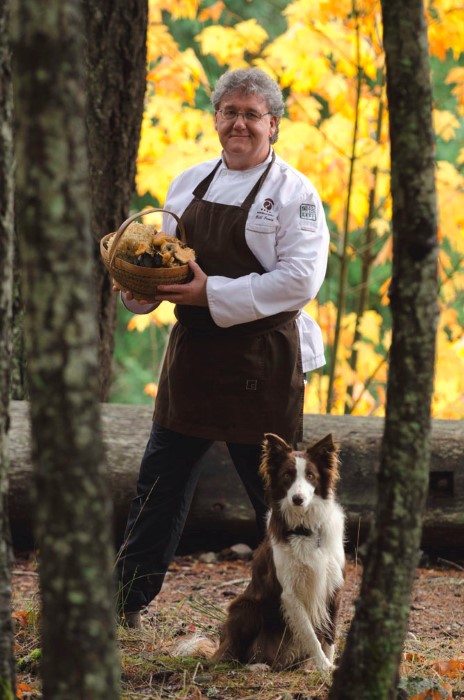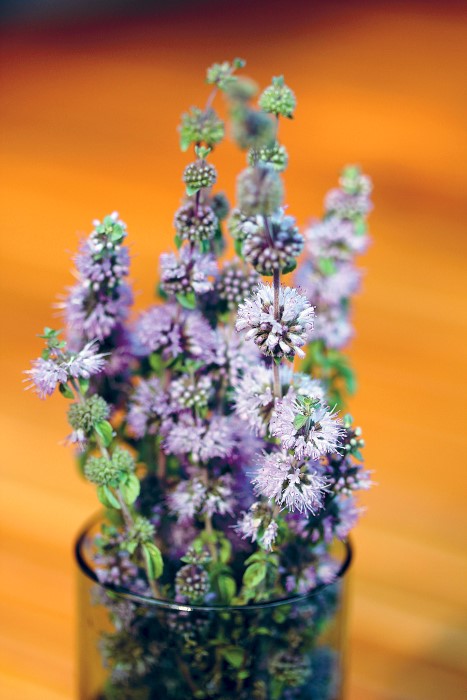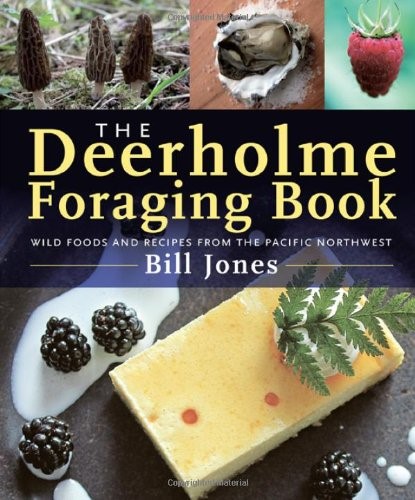Bill Jones is an expert in the woods and absolutely inspired in the kitchen, which is why he combined two of his greatest passions to create his most recent cookbook, The Deerholme Foraging Book: Wild Foods and Recipes from the Pacific Northwest (TouchWood). 
The cookbook champions a return to depending on the bounty of the wild. Many of the greens, berries, and herbs we hunt for the table are not native to the Pacific Northwest. They spread with the migration of people and were helped along in many cases by animals and birds. Many of the plants are now considered invasive species that reduce the value of other commercial crops, leading corporations to spend a fortune in the attempt to cull these ‘weeds’. It is ironic that many of the weeds are more nutritious than the crops we try to protect.
Of course, it is absolutely imperative that you use care when foraging—in addition to the danger of consuming poisonous plants there is also danger of over-harvesting. Many plants are found in specific ecosystems and can quite easily become endangered due to carelessness. It is extremely important that you pick only plants that are abundant. For instance: Mint (Mentha arvensis)
 Wild mint is common in the wet areas and fields of the region. You might notice it when the plant flowers in the summer. The purple-blue flowers are very pretty and tend to produce short spikes of colour often in a sea of green. The plant is most tender in the early summer and becomes more intensely minty as the summer progresses. Wild mint is strongly flavoured and has a slight bitter edge. It makes an excellent tea and is a nice addition to salads, and it makes an incredible Crème Caramel!
Wild mint is common in the wet areas and fields of the region. You might notice it when the plant flowers in the summer. The purple-blue flowers are very pretty and tend to produce short spikes of colour often in a sea of green. The plant is most tender in the early summer and becomes more intensely minty as the summer progresses. Wild mint is strongly flavoured and has a slight bitter edge. It makes an excellent tea and is a nice addition to salads, and it makes an incredible Crème Caramel!
Wild Mint Crème Caramel

- ¾ cup (175 mL) sugar, divided
- ¼ cup (60 mL) water
- 1 tsp (5 mL) butter
- 2 cups (500 mL) whipping cream
- 1 cup (250 mL) mint leaves
- 4 large eggs
- boiling water
Crème caramel is one of the world’s favourite desserts. I have made versions with several wild products including grand fir, sweet cicely, liquorice fern, and wildflower honey. One trick is to keep the oven temperature low and cook the custard until the edges set and the centre is still a little wobbly. The custard will continue to set up as it cools.
In a saucepan over high heat, combine a ¼ cup (60 mL) of the sugar with the water. Bring to a boil; reduce until the sugar begins to form large bubbles and begins to turn a light shade of golden brown on the edges. Add the butter and continue to cook until the butter has stopped foaming and the caramel is a nice golden brown (but not too dark or it will be bitter). The caramel will continue to cook in the pan so you must work quickly. Pour some of the caramel into 6 ramekins, covering the bottom of each one. Don’t worry if there is leftover caramel in the pan.
Pour the cream into the saucepan that held the caramel. Add the mint and bring to a boil. Remove pan from the heat and let sit for 10 minutes.
Preheat the oven at 325°F (160°C).
Strain the mint from the cream. Return the pan with the cream to the stove, and bring to a simmer. Meanwhile, place the remaining ½ cup (125 mL) of sugar and the eggs in a mixing bowl; whisk until smooth. As soon as the cream reaches a boil, pour a third gently into the egg mixture, whisking constantly. Pour the remaining cream into the eggs and strain the custard into a clean bowl or pouring jug. Ladle or pour the custard mix into the ramekins.
Place the ramekins in an ovenproof pan and place the pan in the oven. Pour boiling water into the bottom of the pan, to cover half of the ramekin depth. Close the oven door and bake for 20–25 minutes, or until the custard is just set (it will still wobble gently in the centre when cooked). Transfer the ramekins to a cooling rack; cool to room temperature. Cover ramekins in plastic and chill until needed.
To serve, run a knife around the edge of each ramekin. Invert onto plates and gently shake until the custards slide out onto the plates.
Makes six custards.
Photos/recipe courtesy of TouchWood Editions




